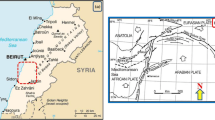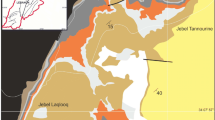Abstract
Complex electrical resistivity and permeability were measured on two gneiss samples and nine amphibolites (originally located at a depth of 4150 m to 5012 m) from the main drilling of the German deep drilling project (KTB). Measurements were performed as a function of hydrostatic pressures up to 240 MPa on core samples (30 mm in diameter and 10–20 mm high). For each measurement, two samples were used, one being parallel, and one perpendicular to the borehole axis. At low pressures and again at maximum pressure the frequency dispersion (1 kHz up to 1 MHz) of the complex resistivity was measured using a two electrode device. An unusual pressure effect was detected on some of the samples and was established to be due to the oriented deposition of good conducting phases in the foliation. Rock fabric and the orientation of ore mineralization was measured on thin sections and polished sections prepared from the same samples.
Similar content being viewed by others
References
Bernabe, Y.: 1986, ‘Pore Volume and Transport Properties Changes During Pressure Cycling of Several Crystalline Rocks’,Mechanics of Materials 5, 235–249.
Bernabe, Y.: 1988, ‘Comparison of the Effective Pressure Law for Permeability and Resistivity Formation Factor in Chelmsford Granite’,Pageoph 127, No. 4: 607–625.
Börner, F., Jung, F. and Schön, J.H.: 1991, ‘Complex Electrical Conductivity of KTB Samples in the Frequency Range Between 10−3 and 104 Hz - First Results’,Scientific Drilling 2, 102–104.
Brace, W. F., Orange, A. S. and Madden, T. R.: 1965, ‘The Effect of Pressure on the Electrical Resistivity of Water Saturated Crystalline Rocks’,J. Geophsy. Res. 70, 5669–5678.
Bücker, C., Huenges, E., Lippmann, E., Rauen, A., Streit, K. M., Wienand, J. and Soffel, H. C.: 1990, ‘KTB Pilot Hole. Results Obtained in the KTB Field Laboratory’KTB Report 90–8, D1–D29.
Duba, A. and Shankland, T. J.: 1982, ‘Free Carbon and Electrical Conductivity in the Earth's Mantle’,Geophys. Res. Let. 9, NO. 11, 1271–1274.
Duba, A., Huenges E., Nover, G., Will, G. and Jödicke, H.: 1988, ‘Impedance of Blackshale from Münsterland 1 Borehole: An Anomalous Good Conductor?’Geophysical Journal 94, 413–419.
Duba, A., Heikamp, S., W. Meurer, Nover, G. and Will, G.: 1994, ‘Evidence from Borehole Samples for the Role of Accessory Minerals in Lower-Crustal Conductivity’,Nature 367, 6, January 1994.
Figgemeier, C., Machon, L., Kamm, H., Hansmann, J., Gleiß, N., Umsonst,T. and Erzinger, J.: 1992, ‘KTB Hauptbohrung, Geoscientific Investigations in the KTB-Field-Laboratory, Depth interval 0–6000 m’.KTB Report,92-2, C1–C45.
Glover, P. W. J. and Vine, F. J.: 1992, ‘Electrical Conductivity of Carbon Bearing Granulite at Raised Temperatures and Pressures’,Nature,360, 723–725.
Haak, V.: 1989, ‘Electrical Resistivity Studies in the Vicinity of the KTB Drill Site’, Oberpfalz. In. Emmermann, R. and Wohlenberg, J. (eds.).The German Continental Deep Drilling program (KTB) - Site selection Studies in the Oberpfalz and Schwarzwald Springer; Berlin, Heidelberg, London; Paris, Tokyo, Hong Kong; 527–553.
Haak, V., Stoll, J. and Winter, H.: 1991, ‘Why is the Electrical Resistivity around the KTB Hole so Low?’,Phys. Earth Planet. Int. 66, 12–23.
Huenges, E., Wienand, J. and Nover, G.: 1990, ‘KTB Pilot Hole: Permeability Profile’,KTB Report 90–8, I1–I6.
Hyndmann, R. D. and Shearer, P. M.: 1989, ‘Water in the Lower Continental Crust: Modelling Magnetotelluric and Seismic Reflection Results’,Geophys. J. Int. 98, 343–365.
Jödicke, H.: 1992, ‘Water and Graphite in the Earth's Crust - An Approach to Interpretation of Conductivity Models’,Surveys in Geophysics 13, 381–407.
Johnson, D. L. and Sen, P. N.: 1988, ‘Dependence of the Conductivity of a Porous Medium on Electrolyte Conductivity’,Physical Review B,37, 3502–3510.
Johnson, D. L. and Manning, H. J.: 1986, ‘Theorie of Pressure Dependent Resistivity in Crystalline Rocks’,Journal of Geophys. Res. 91, No. B11, 11611–11617.
Kontny, A., Keyssner, S. and Friedrich, G.: 1993, ‘Ore Petrology in the KTB Hauptbohrung (6000–7220 m)’,KTB Report 93-2, 511–514.
Kontny, A.: 1994, ‘Bildungsbedingungen von Erzmineralen in metamorphen Krustengesteinen der KTB-Bohrungen / Oberpfalz’, Dissertation RWTH Aachen, 155p.
Lich, S., Duyster, J., Godizart, G., Keyssner, S. and de Wall, H.: 1992, ‘German Continental Deep Drilling Program (KTB) - Geological Survey of the Hauptbohrung 0–6000 m’,KTB-Report 92-2, B1–B42, ed. R. Emmermann, Schweizerbart'sche Verlagsbuchhandlung Stuttgart.
Lockner, D. A. and Byerlee, J. D.: 1985. ‘Complex Resistivity Measurements of Confined Rock’,J. Geophys. Res.,90, B9, 7837–7847.
Nover, G. and Will, G.: 1991, ‘Laboratory Measurements on KTB Core Samples: Core Samples: Complex Resistivity, Zeta Potential, Permeability and Density as a Tool for the Detection of Flow Phenomena’,Scientific Drilling 2, 90–100.
O'Brian, P. C., Röhr, C., Okrusch, M. and Patzak, M.: 1992, ‘Eclogite Facies and a Multistage Breakdown in Metabasites of the KTB Pilot Hole, North-East Bavaria: Implications for the Variscian Tectonometamorphic Evolution of the NW Bohemian’,Massif. Contr. Mineral. Petrol. 112, 261–278.
Rauen, A.: 1991, ‘Untersuchungen des komplexen elektrischen Widerstandes, insbesondere dessen Anisotropie und Frequenzabhängigkeit, von Proben des Kontinentalen Tiefbohrprogramms der Bundesrepublik Deutschland (KTB)’, Thesis, Fakultät für Geowisenschaften der Universität München.
Rauen, A. and Soffel, H.C.: 1993, ‘Determination of Electrical Resistivity, Its Anisotropy and Heterogenity on Drill Cores - A New Method’, submitted toGeophysical Prospecting.
Ruffet, C., Gueguen, Y. and Darot, M.: 1991, ‘Complex Conductivity Measurements and Fractal Nature of Porosity’,Geophysics 56, 758–768.
Schalkwijk, G.: 1991, ‘Matebasites in the Pilot Borehole of the German Continental Deep Drilling Project, Windischeschenbach, Eastern Bavaria. Structures and Fabrics as Documents of Crustal Evolution’. Dissertation Universität Bochum, 203 p.
Siegesmund, S., Vollbrecht, A. and Nover, G.: 1991, ‘Anisotropy of Compressional Wave Velocities, Complex Electrical Resistivity and Magnetic Suszeptibility of Mylonites from the Deeper Crust and their Relation to the Rock Fabric’,Earth Planet Science Letters 105, 247–259.
Siegesmund, S., Vollbrecht, A., Chlupac, T., Nover, G., Dürrast, H., Müller, J. and Weber, K.: 1994, ‘Fabric-Controlled Anisotropy of Petrophysical Properties Observed in KTB Core Samples’,Scientific Drilling 4, 31–54.
Shankland, T. J. and Waff, H. S.: 1974, ‘Conductivity in Fluid Bearing Rocks’,J. Geophys. Res. 79, 4863–4868.
Soffel, H. C., Bücker, C., Gebrande, H., Huenges, E., Lippmann, E., Pohl, J., Rauen, A., Schult, A., Streit, K. M. and Wienand, J.: 1992, ‘Physical Parameters Measured on Cores and Cuttings from the Pilot Hole Well (0 m - 4000.1 m) of the German Continental Deep Drilling Program (KTB) in the Oberpfalz area, Bavaria, Federal Republic of Germany’,Surveys in Geophysics 13, 1–34.
Stoll, J.: 1993, ‘A Mise-a-la-masse Experiment for Detecting an Electrical Network in Cataclastic Zones around the KTB-Site’,KTB Report 93-2, 361–364.
Stoll, J.: 1990, ‘Messung der Eigenpotentialanoamalie im KTB Umfeld und deren Interpretation’, In: K. Bram (ed),KTB Report 90–3, 173–194.
Trimmer, D., Bonner, B., Heard, H.C. and Duba, A.: 1980, ‘Effect of Pressure and Stress on Water Transport in Intact and Fractured Gabbro and Granite’,J. Geophys. Res. 85, 7059–7071.
Zoback, M. D., and Byerlee, J. D.: 1975, ‘The Effect of Microcrack Dilatancy on the Permeability of Westerly Granite’,J. Geophys. Res. 80 (5), 752–755.
Author information
Authors and Affiliations
Rights and permissions
About this article
Cite this article
Nover, G., Heikamp, S., Kontny, A. et al. The effect of pressure on the electrical conductivity of KTB rocks. Surv Geophys 16, 63–81 (1995). https://doi.org/10.1007/BF00682713
Received:
Issue Date:
DOI: https://doi.org/10.1007/BF00682713




